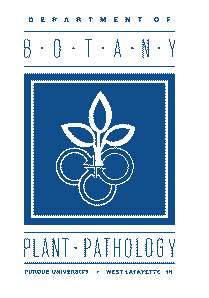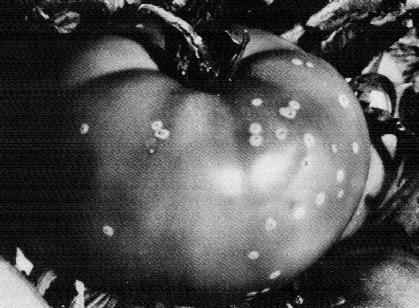
BP-14-W

Bacterial canker is an infectious disease of fresh-market and processing tomatoes that usually results in reduced yields and premature fruit drop. The white blisters, which occur on infected tomatoes, reduce the fresh-market value of the fruit. Bacterial canker can spread rapidly through a crop and can cause near total losses.
Symptoms of bacterial canker occur on all above ground plant parts, but the first symptoms usually appear on older leaves. The margins of infected leaves appear brown and scorched; they are curled upward and inward. Borders between the brown and green areas of the leaves are distinct. They are often separated by a thin line of yellow tissue. In the advanced stages of infection, these symptoms occur on all leaflets of an infected leaf and are unmistakable to the experienced observer. Early recognition of leaf symptoms can save valuable time in the diagnostic process.
Light streaks usually develop on infected stems and shoots. These streaks grow progressively darker and eventually split, forming a shallow canker. Vascular tissue of infected plant stems is discolored, usually yellow or tan. Interference with water transport, which is caused by the cankers, results in wilting of all or part of the plant.
Bacterial canker is most easily recognized by the appearance of raised, white blisters (1/16-1/8 inches in diameter) on green or red fruit (Figure 1). The blisters are often referred to as "bird's eye" spots.

In the field, leaf symptoms should make the observer suspicious of canker; however, the appearance of white blisters on the fruit confirms the suspicion.
Bacterial canker is introduced to previously uninfested areas by infected seeds or transplants. Once established in the field, the bacteria may survive on infested plant residue for up to three years. Materials used in the process of raising seedlings and plants (wooden flats, benches, and stakes) may harbor the bacteria from one season to the next; and also, the bacterial canker pathogen has been found to survive the winter in weed hosts.
The pathogen is spread within the field by windblown rain or sprinkler irrigation. Bacteria ooze from cankers in wet or humid weather; then when the rain splashes on the cankers, it spreads the bacteria to other plants. Mechanical cultivation and hand harvesting can also spread the bacteria (this is especially important of fresh-market crops).
Prevention is the only acceptable strategy for control of bacterial canker; therefore, use of disease-free seeds and disease-free transplants is the crucial control measure. Once bacterial canker becomes established, repeated application of copper compounds may reduce the rate of disease spread but should not be considered a reliable control measure. Fresh-market tomato growers should rogue and/or isolate plants with symptoms of bacterial canker.
Infested fields should be rotated out of tomatoes for at least three years. In addition, production materials and structures should be disinfected by using a 10 percent chlorine bleach solution. Weeds related to tomatoes (nightshade) should be controlled; these weeds may harbor bacteria.
For additional information, contact your county Extension Office or write the Publications Mailing Room, 301 South Second St., Lafayette, IN 47905-1092.
RR 11/93
Cooperative Extension work in Agriculture and Home Economics, state of Indiana, Purdue University, and U.S. Department of Agriculture cooperating; HA. Wadsworth, Director, West Lafayette. IN. Issued in furtherance of the acts of May 8 and June 30, 1914. Purdue University Cooperative Extension Service is an equal opportunity/equal access institution.